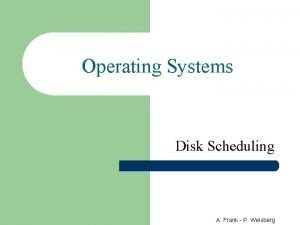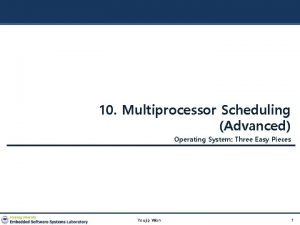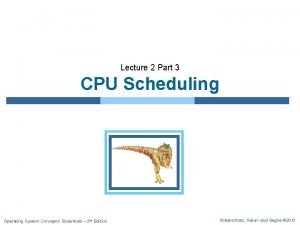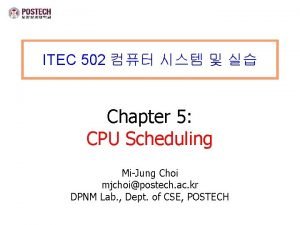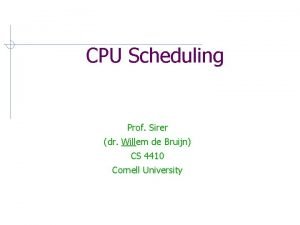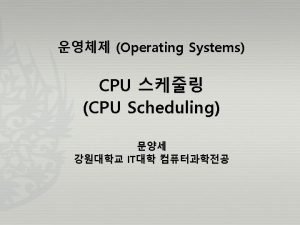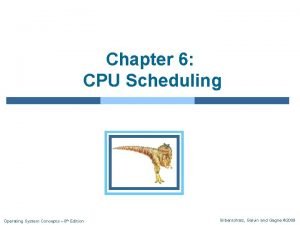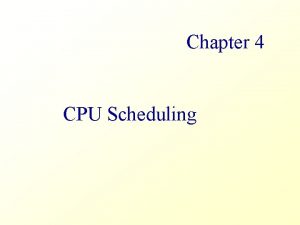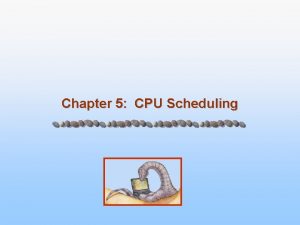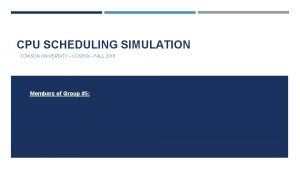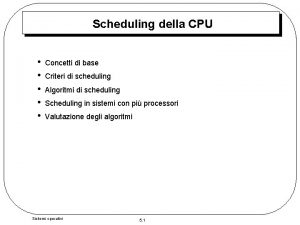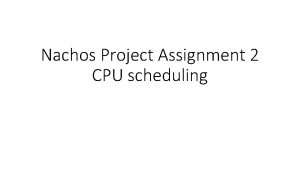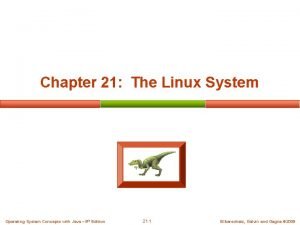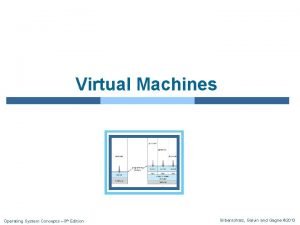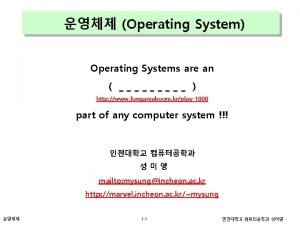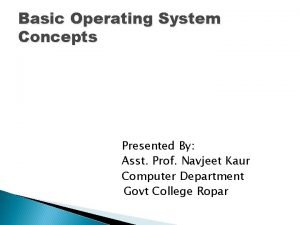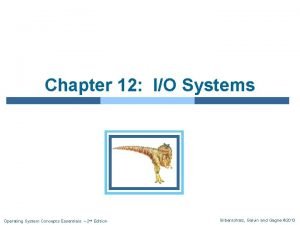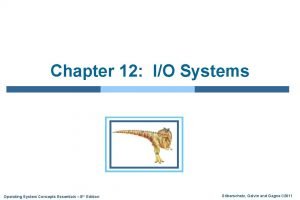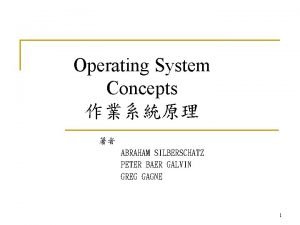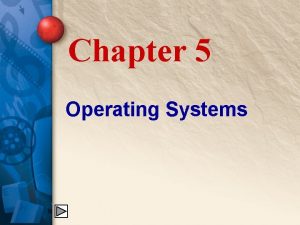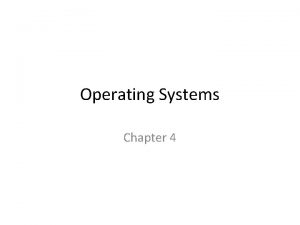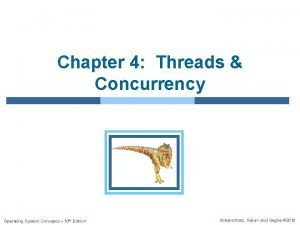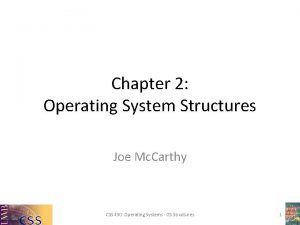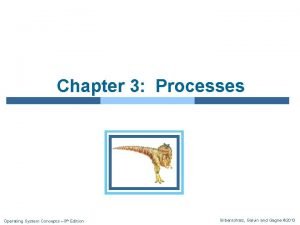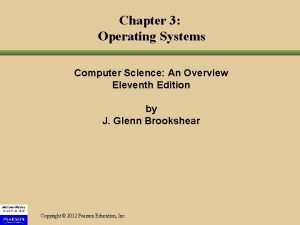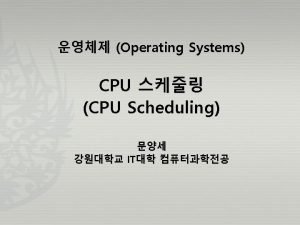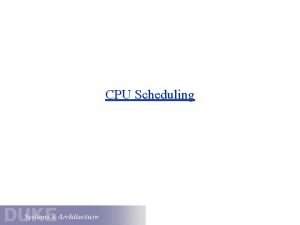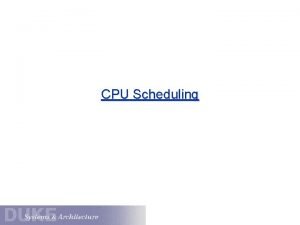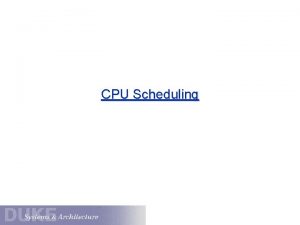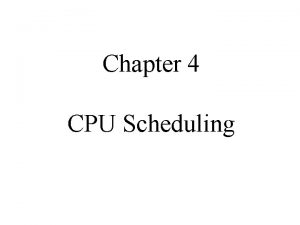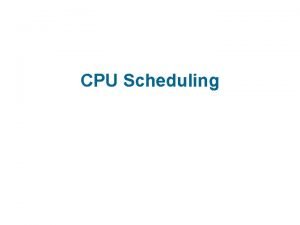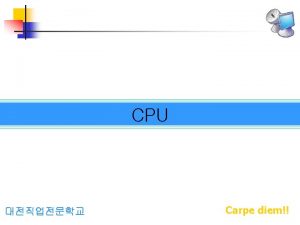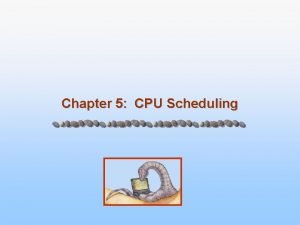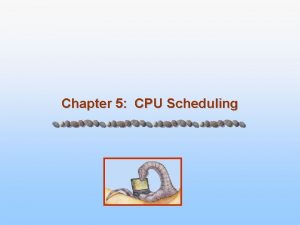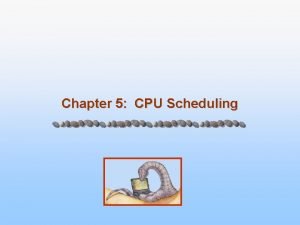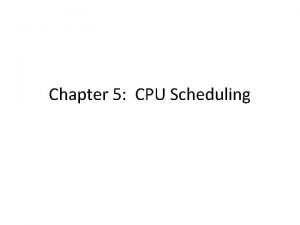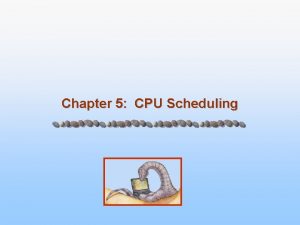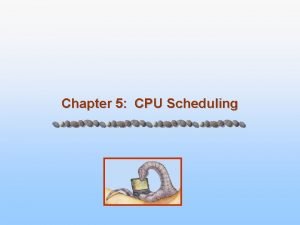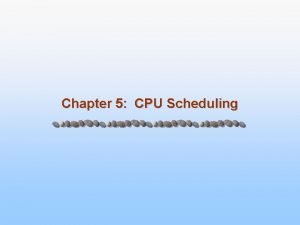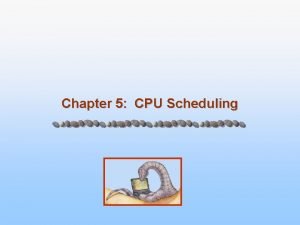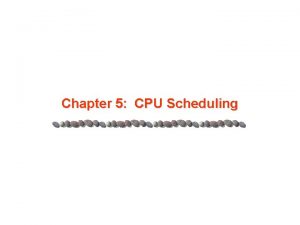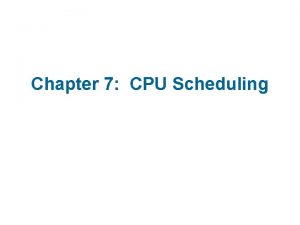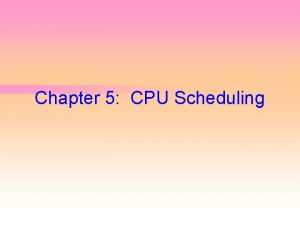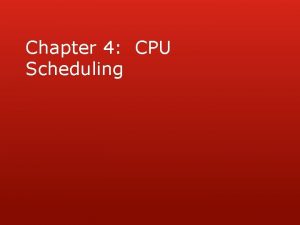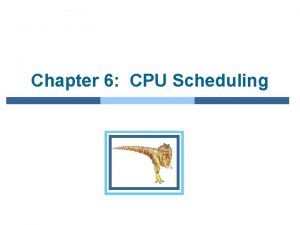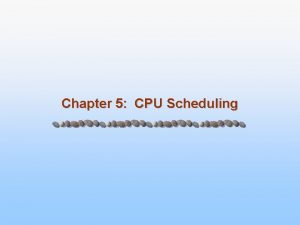Chapter 6 CPU Scheduling Operating System Concepts 9










































- Slides: 42

Chapter 6: CPU Scheduling Operating System Concepts – 9 th Edition Silberschatz, Galvin and Gagne © 2013

Chapter 6: CPU Scheduling n Basic Concepts n Scheduling Criteria n Scheduling Algorithms n Multiple-Processor Scheduling n Real-Time CPU Scheduling Operating System Concepts – 9 th Edition 6. 2 Silberschatz, Galvin and Gagne © 2013

Objectives n To introduce CPU scheduling, which is the basis for multiprogrammed operating systems n To describe various CPU-scheduling algorithms Operating System Concepts – 9 th Edition 6. 3 Silberschatz, Galvin and Gagne © 2013

Chapter 6: CPU Scheduling n Basic Concepts n Scheduling Criteria n Scheduling Algorithms n Multiple-Processor Scheduling n Real-Time CPU Scheduling Operating System Concepts – 9 th Edition 6. 4 Silberschatz, Galvin and Gagne © 2013

Basic Concepts n Maximum CPU utilization obtained with multiprogramming n CPU–I/O Burst Cycle – Process execution consists of a cycle of CPU execution and I/O wait n CPU burst followed by I/O burst n CPU burst distribution is of main concern Operating System Concepts – 9 th Edition 6. 5 Silberschatz, Galvin and Gagne © 2013

Histogram of CPU-burst Times n Most often, we only look at one CPU-burst of a process when talking about scheduling algorithms Operating System Concepts – 9 th Edition 6. 6 Silberschatz, Galvin and Gagne © 2013

CPU Scheduler n Short-term scheduler selects from among the processes in ready queue, and allocates the CPU to one of them l Queue may be ordered in various ways n CPU scheduling decisions may take place when a process: 1. Switches from running to waiting state 4 2. Switches from running to ready state 4 l An interrupt occurs or the process finishes its time slot Switches from waiting to ready 4 l I/O request or wait() for child process Completion of I/O Terminates n Scheduling under 1 and 4 is nonpreemptive n All other scheduling is preemptive Operating System Concepts – 9 th Edition 6. 7 Silberschatz, Galvin and Gagne © 2013

Dispatcher n Dispatcher module gives control of the CPU to the process selected by the short-term scheduler; this involves: l switching context l switching to user mode l jumping to the proper location in the user program to restart that program n Dispatch latency – time it takes for the dispatcher to stop one process and start another running Operating System Concepts – 9 th Edition 6. 8 Silberschatz, Galvin and Gagne © 2013

Chapter 6: CPU Scheduling n Basic Concepts n Scheduling Criteria n Scheduling Algorithms n Multiple-Processor Scheduling n Real-Time CPU Scheduling Operating System Concepts – 9 th Edition 6. 9 Silberschatz, Galvin and Gagne © 2013

Scheduling Criteria n CPU utilization – what percentage of CPU time is used for computation instead of idling n Throughput – # of processes that complete their execution per time unit n Turnaround time – amount of time to execute a particular process l The interval from the time of submission of a process to the time of completion n Waiting time – amount of time a process has been waiting in the ready queue n Response time – amount of time it takes from when a request was submitted until the first response is produced, not output (for time-sharing environment) Operating System Concepts – 9 th Edition 6. 10 Silberschatz, Galvin and Gagne © 2013

Scheduling Algorithm Optimization Criteria n Max CPU utilization n Max throughput n Min turnaround time n Min waiting time n Min response time Operating System Concepts – 9 th Edition 6. 11 Silberschatz, Galvin and Gagne © 2013

Chapter 6: CPU Scheduling n Basic Concepts n Scheduling Criteria n Scheduling Algorithms l First-come, first-served scheduling l Shortest-job-first scheduling l Priority scheduling l Round-robin scheduling l Multilevel queue scheduling l Multilevel feedback queue scheduling n Multiple-Processor Scheduling n Real-Time CPU Scheduling Operating System Concepts – 9 th Edition 6. 12 Silberschatz, Galvin and Gagne © 2013

First- Come, First-Served (FCFS) Scheduling Process Burst Time P 1 24 P 2 3 P 3 3 n Suppose that the processes arrive in the order at time 0: P 1 , P 2 , P 3 The Gantt Chart for the schedule is: n Waiting time for P 1 = 0; P 2 = 24; P 3 = 27 n Average waiting time: (0 + 24 + 27)/3 = 17 Operating System Concepts – 9 th Edition 6. 13 Silberschatz, Galvin and Gagne © 2013

FCFS Scheduling (Cont. ) Suppose that the processes arrive in the order at time 0: P 2 , P 3 , P 1 n The Gantt chart for the schedule is: n Waiting time for P 1 = 6; P 2 = 0; P 3 = 3 n Average waiting time: (6 + 0 + 3)/3 = 3 n Much better than previous case n Convoy effect - short process behind long process l Consider one CPU-bound and many I/O-bound processes Operating System Concepts – 9 th Edition 6. 14 Silberschatz, Galvin and Gagne © 2013

Shortest-Job-First (SJF) Scheduling n Associate with each process the length of its next CPU burst l Use these lengths to schedule the process with the shortest time n SJF is optimal – gives minimum average waiting time for a given set of processes l The difficulty is to know the length of the next CPU request l Could ask the user Operating System Concepts – 9 th Edition 6. 15 Silberschatz, Galvin and Gagne © 2013

Example of SJF Process. Arrival Time Burst Time P 1 0. 0 6 P 2 2. 0 8 P 3 4. 0 7 P 4 5. 0 3 n Four processes arrive at time 0 n SJF scheduling chart n Average waiting time = (3 + 16 + 9 + 0) / 4 = 7 Operating System Concepts – 9 th Edition 6. 16 Silberschatz, Galvin and Gagne © 2013

Determining Length of Next CPU Burst n Can only estimate the length – should be similar to the previous one l Then pick process with shortest predicted next CPU burst n Can be done by using the length of previous CPU bursts, using exponential averaging n Commonly, α set to ½ Operating System Concepts – 9 th Edition 6. 17 Silberschatz, Galvin and Gagne © 2013

Prediction of the Length of the Next CPU Burst n CPU burst (ti): 6 4 13 13 13 … n Guess ( i): 10 8 6 6 Operating System Concepts – 9 th Edition 5 9 6. 18 11 12 … Silberschatz, Galvin and Gagne © 2013

Examples of Exponential Averaging n =0 n+1 = n l Recent history does not count n =1 l n+1 = tn l Only the actual last CPU burst counts n If we expand the formula, we get: n+1 = tn+(1 - ) tn -1 + … +(1 - )j tn -j + … l +(1 - )n +1 0 n Since both and (1 - ) are less than or equal to 1, each successive term has less weight than its predecessor Operating System Concepts – 9 th Edition 6. 19 Silberschatz, Galvin and Gagne © 2013

Example of Shortest-remaining-time-first n Now we add the concepts of varying arrival times and preemption to the analysis Process. Aarri Arrival Time. T Burst Time P 1 0 8 P 2 1 4 P 3 2 9 P 4 3 5 n Preemptive SJF Gantt Chart n Average waiting time = [(10 -1)+(17 -2)+(5 -3)]/4 = 26/4 = 6. 5 msec Operating System Concepts – 9 th Edition 6. 20 Silberschatz, Galvin and Gagne © 2013

Priority Scheduling n A priority number (integer) is associated with each process n The CPU is allocated to the process with the highest priority (smallest integer highest priority) l Preemptive l Nonpreemptive n SJF is priority scheduling where priority is the inverse of predicted next CPU burst time n Problem Starvation – low priority processes may never execute n Solution Aging – as time progresses increase the priority of the process Operating System Concepts – 9 th Edition 6. 21 Silberschatz, Galvin and Gagne © 2013

Example of Priority Scheduling Process. A arri Burst Time. T Priority P 1 10 3 P 2 1 1 P 3 2 4 P 4 1 5 P 5 5 2 n Five processes arrive at time 0 n Priority scheduling Gantt Chart n Average waiting time = 8. 2 msec Operating System Concepts – 9 th Edition 6. 22 Silberschatz, Galvin and Gagne © 2013

Round Robin (RR) n Each process gets a small unit of CPU time (time quantum q) l Usually 10 -100 milliseconds l After this time has elapsed, the process is preempted and added to the end of the ready queue. n If there are n processes in the ready queue and the time quantum is q l Each process gets 1/n of the CPU time in chunks of at most q time units at once l No process waits more than (n-1)q time units. n Timer interrupts every quantum to schedule next process n Performance l q large FIFO l q small q must be large with respect to context switch, otherwise overhead is too high Operating System Concepts – 9 th Edition 6. 23 Silberschatz, Galvin and Gagne © 2013

Example of RR with Time Quantum = 4 Process Burst Time P 1 P 2 P 3 n Three processes arrive at time 0 n The Gantt chart is: 24 3 3 n Typically, higher average turnaround than SJF, but better response n q should be large compared to context switch time n q usually 10 ms to 100 ms, context switch < 10 usec Operating System Concepts – 9 th Edition 6. 24 Silberschatz, Galvin and Gagne © 2013

Time Quantum and Context Switch Time Operating System Concepts – 9 th Edition 6. 25 Silberschatz, Galvin and Gagne © 2013

Turnaround Time Varies With The Time Quantum n Four processes arrive at time 0 Operating System Concepts – 9 th Edition 6. 26 Silberschatz, Galvin and Gagne © 2013

Multilevel Queue n Ready queue is partitioned into separate queues, e. g. , l foreground (interactive) l background (batch) n Process permanently in a given queue n Each queue has its own scheduling algorithm, e. g. , l foreground – RR l background – FCFS n Scheduling must be done between the queues: l Fixed priority scheduling; (i. e. , serve all from foreground then from background). Possibility of starvation. l Time slice – each queue gets a certain amount of CPU time which it can schedule amongst its processes; 4 e. g. , 80% to foreground in RR, 20% to background in FCFS Operating System Concepts – 9 th Edition 6. 27 Silberschatz, Galvin and Gagne © 2013

Multilevel Queue Scheduling Operating System Concepts – 9 th Edition 6. 28 Silberschatz, Galvin and Gagne © 2013

Multilevel Feedback Queue n A process can move between the various queues; aging can be implemented this way n Multilevel-feedback-queue scheduler defined by the following parameters: l number of queues l scheduling algorithms for each queue l method used to determine when to upgrade a process l method used to determine when to demote a process l method used to determine which queue a process will enter when that process needs service Operating System Concepts – 9 th Edition 6. 29 Silberschatz, Galvin and Gagne © 2013

Example of Multilevel Feedback Queue n Three queues: l Q 0 – RR with time quantum 8 milliseconds l Q 1 – RR time quantum 16 milliseconds l Q 2 – FCFS n Scheduling l l A new job enters queue Q 0 which is served FCFS 4 When it gains CPU, job receives 8 milliseconds 4 If it does not finish in 8 milliseconds, job is moved to queue Q 1 At Q 1 job is again served FCFS and receives 16 additional milliseconds 4 If it still does not complete, it is preempted and moved to queue Q 2 Operating System Concepts – 9 th Edition 6. 30 Silberschatz, Galvin and Gagne © 2013

Chapter 6: CPU Scheduling n Basic Concepts n Scheduling Criteria n Scheduling Algorithms n Multiple-Processor Scheduling n Real-Time CPU Scheduling Operating System Concepts – 9 th Edition 6. 31 Silberschatz, Galvin and Gagne © 2013

Multiple-Processor Scheduling n CPU scheduling more complex when multiple CPUs or multiple cores are available n Homogeneous processors within a multiprocessor n Asymmetric multiprocessing – only one processor accesses the system data structures, alleviating the need for data sharing n Symmetric multiprocessing (SMP) – each processor is self- scheduling, all processes in common ready queue, or each has its own private queue of ready processes l Currently, most common n Processor affinity – process has affinity for processor on which it is currently running l soft affinity 4 OS l attempts to keep a process running on the same processor hard affinity 4 Allow a process to specify a subset of processors on which it may run Operating System Concepts – 9 th Edition 6. 32 Silberschatz, Galvin and Gagne © 2013

NUMA and CPU Scheduling Note that memory-placement algorithms can also consider affinity NUMA: non-uniform memory access Operating System Concepts – 9 th Edition 6. 33 Silberschatz, Galvin and Gagne © 2013

Multiple-Processor Scheduling – Load Balancing n If SMP, need to keep all CPUs loaded for efficiency n Load balancing attempts to keep workload evenly distributed n Push migration – periodic task checks load on each processor, and if found pushes task from overloaded CPU to other CPUs n Pull migration – idle processors pulls waiting task from busy processor Operating System Concepts – 9 th Edition 6. 34 Silberschatz, Galvin and Gagne © 2013

Chapter 6: CPU Scheduling n Basic Concepts n Scheduling Criteria n Scheduling Algorithms n Multiple-Processor Scheduling n Real-Time CPU Scheduling Operating System Concepts – 9 th Edition 6. 35 Silberschatz, Galvin and Gagne © 2013

Real-Time CPU Scheduling n Can present obvious challenges n Soft real-time systems l No guarantee as to when critical real-time process will be scheduled l Only guarantee that critical real-time process will be given preferences over noncritical processes n Hard real-time systems l Task must be serviced by its deadline 4 The moment before which the task has to be completed Operating System Concepts – 9 th Edition 6. 36 Silberschatz, Galvin and Gagne © 2013

Priority-based Scheduling n For real-time scheduling, scheduler must support preemptive, priority- based scheduling l But only guarantees soft real-time n Hard real-time systems must also provide ability to meet deadlines n Processes have new characteristics: periodic ones require CPU at constant intervals l Has processing time t, deadline d, period p l 0≤t≤d≤p l Rate of periodic task is 1/p Operating System Concepts – 9 th Edition 6. 37 Silberschatz, Galvin and Gagne © 2013

Rate Monotonic Scheduling n A priority is statically assigned based on the inverse of its period l Shorter periods = higher priority l Longer periods = lower priority n Example: P 1 is assigned a higher priority than P 2 l p 1=50, p 2=100 l t 1=20, t 2=35 l Deadline of both: the start of the next cycle Operating System Concepts – 9 th Edition 6. 38 Silberschatz, Galvin and Gagne © 2013

Missed Deadlines with Rate Monotonic Scheduling n Example: P 1 is assigned a higher priority than P 2 l p 1=50, p 2=80 l t 1=25, t 2=35 l Deadline of both: the start of the next cycle Operating System Concepts – 9 th Edition 6. 39 Silberschatz, Galvin and Gagne © 2013

Earliest Deadline First Scheduling (EDF) n Priorities are assigned according to deadlines l The earlier the deadline, the higher the priority l The later the deadline, the lower the priority l Processes don’t have to be periodic any more 4 A process has to announce its deadline n Example: P 1 and P 2 l p 1=50, p 2=80 l t 1=25, t 2=35 l Deadline of both: the start of the next cycle Operating System Concepts – 9 th Edition 6. 40 Silberschatz, Galvin and Gagne © 2013

Proportional Share Scheduling n T shares are allocated among all processes in the system n An application receives N shares where N < T n This ensures each application will receive N / T of the total processor time n Example: T = 100 shares l Process A: 50 shares l Process B: 15 shares l Process C: 20 shares Operating System Concepts – 9 th Edition 6. 41 Silberschatz, Galvin and Gagne © 2013

End of Chapter 6 Operating System Concepts – 9 th Edition Silberschatz, Galvin and Gagne © 2013
 Operating system concepts chapter 8 solutions
Operating system concepts chapter 8 solutions Operating system concepts chapter 5 solutions
Operating system concepts chapter 5 solutions Operating system concepts chapter 5 solutions
Operating system concepts chapter 5 solutions Disk structure in os
Disk structure in os Advanced operating system
Advanced operating system Sjf cpu scheduling
Sjf cpu scheduling Cpu scheduling gantt chart
Cpu scheduling gantt chart Sjf cpu scheduling
Sjf cpu scheduling Fcfs gantt chart
Fcfs gantt chart Sjf cpu scheduling
Sjf cpu scheduling Sjf cpu scheduling
Sjf cpu scheduling Scheduling concept in os
Scheduling concept in os A cpu scheduling algorithm determines an order
A cpu scheduling algorithm determines an order Cpu scheduling project
Cpu scheduling project Scheduling della cpu
Scheduling della cpu Cpu scheduling project
Cpu scheduling project Sjn scheduling
Sjn scheduling Operating system concepts, 10th edition
Operating system concepts, 10th edition Linux operating system concepts
Linux operating system concepts Operating system concepts with java
Operating system concepts with java Operating system concepts 6th edition
Operating system concepts 6th edition Operating system concepts 9
Operating system concepts 9 Real time operating system concepts
Real time operating system concepts 교보 drm
교보 drm Basic concepts of os
Basic concepts of os Operating system concepts 11th
Operating system concepts 11th Operating system concepts essentials
Operating system concepts essentials Operating system concepts essentials
Operating system concepts essentials Abraham silberschatz
Abraham silberschatz Operating systems
Operating systems Buddy system in os
Buddy system in os File system in operating system
File system in operating system Ufs4.0
Ufs4.0 File system in operating system
File system in operating system 5 operating systems
5 operating systems Understanding operating systems
Understanding operating systems Chapter 4 operating system
Chapter 4 operating system Concurrency vs parallelism in os
Concurrency vs parallelism in os Operating system chapter 2
Operating system chapter 2 Operating system chapter 1
Operating system chapter 1 Operating system chapter 3
Operating system chapter 3 Operating system chapter 3
Operating system chapter 3 Scheduling in batch system
Scheduling in batch system



